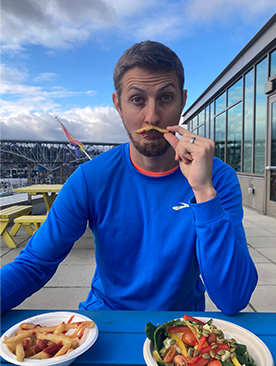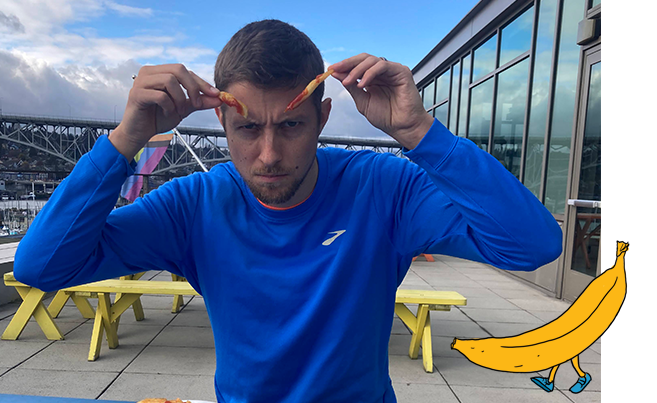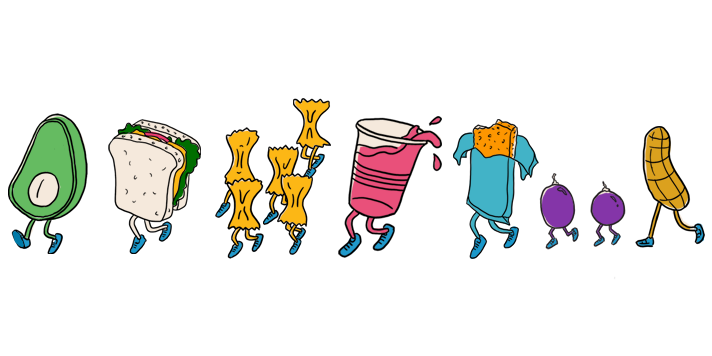Packing calories for peak performance

A pro trail athlete and coach shares insights into his nutrition.
DISCLAIMER: THIS ARTICLE DOES NOT PROVIDE MEDICAL ADVICE
The content in this post is intended for informational or general educational purposes only and it is not intended to be a substitute for professional medical advice, diagnosis, or treatment. Always seek the advice of your physician or other qualified health care provider with any questions you may have regarding a medical condition or treatment and before making any adjustments to your running, nutrition, fitness, or healthcare routines.
Did you know that black bears spend about 20 hours a day eating, averaging 100 pounds of weight gain per week in late summer? Wildlife biologists estimate bears eat about 20,000 calories a day, about five times as much as a pro trail runner eats during training.
Pro runner and Brooks Trail coach Joe McConaughy knows how important it is to eat like a wild animal while training. When he was a freshman in college, he struggled during his first cross-country season and points to his fuel as a key culprit.
“I’d fall asleep in class, and I’d do horribly in all my workouts. When I looked at my diet, I realized I was trying to eat the most cost-efficient foods at the dining hall. My carbs came from French fries and pasta and my protein came from chicken. It made total sense that my body was run down because I wasn’t fueling it properly,” he explained.
McConaughy began to take his nutrition more seriously, and his running improved. He eventually transitioned from track to trail, setting the supported Pacific Crest Trail Fastest Known Time in 2014. In 2017, he set the self-supported Appalachian Trail FKT.


We caught up with him to chat about his training, some book recommendations about nutrition, how many calories are in half a bag of cashews (hint: it’s a lot), and more.
Brooks: Tell us about going from serious road training to trail. How did your training change? How did your nutrition change?
Joe McConaughy: I have gone through some profound changes in my training. I’m really grateful that I didn’t take myself too seriously when I came out of college. I think that has led to a really healthy relationship with running. I also started coaching trail runners in 2017, and that helped refine my approach to training and trails. When I was a college kid, I was doing about 60 miles a week with almost all my runs at 6:15 min/mile pace or faster. Now, I tend to run between 70–95-mile weeks, incorporate a quality amount of vertical gain, and take my easy days easy and hard days hard.
I should give a big shoutout to Katie, my wife, who is wrapping up a master’s degree in Public Health with a focus on dietetics at the University of Washington. She is a wonderful support for me in so many ways, including my daily nutrition. As I’ve gotten older, my biggest focus is on the quantity of food. We do a good job incorporating quality foods into our diets, eating a variety of foods, and eating lots of whole foods. It takes a lot of work to fuel my body appropriately. Katie and I laugh about a time when I sat down and ate half a bag of cashews as a mid-afternoon snack. We did the math after and realized that I had eaten almost 2,000 calories of cashews in less than 20 minutes.
Brooks: How do you eat in the weeks leading up to long haulers? Do you have a diet plan?
JM: I do not have a formal diet plan. I try to buy a variety of foods at the grocery store and let my hunger and palate do the rest. In the weeks leading up to a race, I’m usually finishing up a long block of 10-plus training hour weeks. If I’m feeling flat or fatigued, I usually go to food as a potential offender. Have I been eating enough protein? Enough carbs? Enough calories? Could I be low on vitamin D? Iron? I try to make sure these bases are covered because the body can start to break at the seams if something is missing.

Brooks: Athletes like Michael Phelps and Usain Bolt chowed down enormous calorie loads for practice-heavy weeks. Is that common for runners like you? What are your thoughts?
JM: Yes, this is common for runners. Caloric burn and metabolism are fascinating topics of discussion that I think we will see some really interesting scientific breakthroughs and implications on health in the next decade. “Burn” by Hermann Pontzer is a great book that dissects some of this research in everyday terms.
Brooks: How did you educate yourself on your diet needs? How do you stay educated?
JM: Staying educated on diet is tough. Especially in the dietetics and nutrition world, there is so much crap and misinformation out there. It seems like every other Instagram influencer is trying to convince people of a ‘magic hack’ that will help you lose weight or live a higher-quality life. My rule of thumb is that if someone is preaching something that seems too good to be true, it likely is.
One of my favourite books on a method of how athletes should fuel is the “Endurance Diet” by Matt Fitzgerald. He observes top endurance athletes and tries to identify trends in what and why they eat. When researching nutrition and race performance, I try not to get caught up in any source that might have any kind of bias or be interested in selling me a product. I try to practice basic tenets of eating a variety of foods and eating enough. Throughout my life, I seem to be susceptible to anemia and low vitamin D. So, I’ve talked with medical professionals about bloodwork that I’ve gotten and try to get specific recommendations through them.

Brooks: We heard you are in a research study measuring time vs metabolic output. Can you share what that’s all about?
I was part of a research study directed by doctors Drew Best, Cara Ocobok, and Hermann Pontzer on my metabolic output. They took urine samples over a 10-day training block and throughout two different races. The first race was a record attempt on the Arizona Trail, where I ran about 60 miles a day for 13 days through the state. The other event was the Cocodona 250, a 250-mile race that took about 2.5 days.
We are trying to study the limits of human endurance through ultra-endurance events. The research team has gathered data from a variety of sources and are creating an equation to estimate the max daily metabolic (or caloric) output for endurance events lasting different lengths. So, they’ve taken the average 24-hour caloric output at events from a 100-mile road to a 3,000-mile race across the United States. They’ve found that as the length of an endurance event grows (from hours to days to weeks), the sustained daily output decreases.
With this data, they can make some interesting conclusions. Based on the length of an endurance event, they can estimate a max ceiling of metabolic output that someone can achieve. Using this information, they can also estimate the amount of average caloric burn the body can sustain in training. This likely has implications for endurance performance and training. [editor’s note: This research is still in the process of being published.]

Nutrition is personal
Most runners don’t have extreme caloric needs like McConaughy. It’s important to remember that food and nutrition aren’t things to be solved, mastered, conquered, or perfected.
A healthy relationship with food is adaptable. For runners, this means dismissing the idea that there are magic foods that will work for a workout or on race day. Having a basic understanding of nutrition and energy production can help individuals make smart decisions for good performance and better health.
Learn more about trail running
Check out our athlete page to learn more about the Brooks Trail Elite team. Looking for great gear for your next trail run? Shop the Trail to Toe Collection.